5 Dec 2017
0 CommentsCanada – A Nation Built by (Extra) Ordinary People
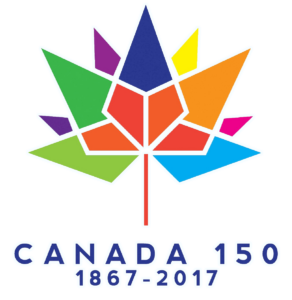 In a previous post, I spoke about my involvement with Canada 150 and also the Canada C3 signature project. The latter is an epic journey divided into 15 “Legs”, on a former Canadian Coast Guard Ice Breaker vessel (the MV Polar Prince, ca 1958) refitted to sail from coast to coast to coast for 150 days, and provide an ideal platform for connections and conversations. As a participant, I can only say I was profoundly changed, inspired, enlightened and mobilized by my time.
In a previous post, I spoke about my involvement with Canada 150 and also the Canada C3 signature project. The latter is an epic journey divided into 15 “Legs”, on a former Canadian Coast Guard Ice Breaker vessel (the MV Polar Prince, ca 1958) refitted to sail from coast to coast to coast for 150 days, and provide an ideal platform for connections and conversations. As a participant, I can only say I was profoundly changed, inspired, enlightened and mobilized by my time.
At our 150th birthday in 2017, Canada is at a crossroads as it strives to outgrow its colonial past, to find its rôle and place in a new world order and to respond to the recent Truth and Reconciliation Commission Report on the mis-treatment of our Indigenous Peoples in Residential Schools.
Compared to the celebration of our history that was the focus of Canada’s Centennial in 1967, Canada C3 responded directly to such challenges and sought to contribute to a new sense of nation building in our country. The ambitious goal was to engage over 20 million Canadians and contribute to a Legacy for our nation as it looks forward to our bicentennial in 2067 and beyond.
Accordingly, the key themes for Canada C3 were crafted to help in this nation building:
- Reconciliation with our Indigenous People, namely First Nations, Métis and Inuit.
- Environment: and in particular the challenges of climate change as well as specific challenges facing our coastline and northern regions. A little known fact is that Canada has the longest coastline of any country in the world. Issues include species loss, micro plastics in our oceans, effects of higher sea levels and much more. See my post here: “Environmental Awakening Fusing of Science, The Arts and Sea Ice”
- Diversity and Inclusion: Canada’s cultural mosaic includes people from all over the world which is a reflection of Canada’s admirable openness and welcoming nature. Although we have always been a country of newcomers. our society still has a way to go to be completely inclusive to: visible minorities, women, LGBT and those with disabilities.
- Youth Engagement: As a baby boomer who was a teenager in 1967, I feel that my generation has proactively shaped the Canada we know today. Our generation has achieved much that is good but there are many areas to address. This is always a work in progress. Similarly, today’s youth must lead our quest for the Canada of 2067 and Canada C3 provided a great vehicle from them to learn,
share, contribute and ultimately act to help us build a future civil society that is just and open.
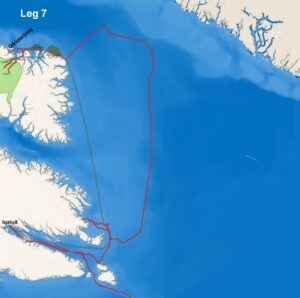
To illustrate this, the ship had about 60 people onboard at any one time, as follows:
- 14 crew – from the amazing Captain Stephan Guy who also made the best bread I’ve had in a long time, and a group of hard working marine experts who worked hard 24/7 to ensure we progressed safely and on time,
- 20 staff – The staff was led by the world’s most innovative outdoor educator, Geoff Green, CM, expedition leader. The staff complement included onboard scientists conducting 25 experiments along the coast of Canada, Zodiac drivers and interpreters; bear guard[ians]; hospitality and cooking; onboard physician; and a Hollywood grade “comms” team of six (2 nationally leading photographers, a videographer, a drone operator and two prolific video and content editors who seemed to work around the clock), and
- 24 participants, for each of the 15 Legs or 360 for the entire expedition, selected in myriad ways, from invitation, partnership and application, including:
- journalists from across Canada
- a chef – each leg had one chef, part of Food Day Canada that celebrates food and food sustainability across Canada from coast to coast to coast
- a visual artist, one per leg, chosen by a Canada Council adjudicated jury
- a writer – ours was an Order of Canada poet who is a national treasure
- a musician
- educators – who could take the conversations back to our schools
- indigenous people – Leg 7 had 2 Inuit leaders and a youth ambassador from our First Nations
- youth ambassadors – we had 3 young people, already showing tremendous leadership and passion. I believe that, at their young age, this journey will be most transformational for them,
- partners, including from Canada Council, Apathy is Boring, etc
- business people,
- and many, many more.
Through my posts, pictures, and videos, you will meet some of the above people, but my focus for this post will be in the communities we visited on our journey. Since it was impossible for each and every Canadian to participate, I hope these posts can help people share and savour even a small portion of what I experienced.
While the backdrop of our journey, the east coast of Baffin Island, represents some of the most spectacular scenery on our planet, it only provided the context for our discussions and learning. Make no mistake, for those who are connoisseurs of art from the Arctic, the sense of lighting and colours seems alien to our more southern eyes, yet addictively beautiful. Compare the colours and textures of the iconic Inuit Artist Jessie Ooonark, Group of Seven member Lawren Harris, and a Brit bewitched by the north Ted Harrison to the real thing:
In posts that will follow, I will focus more on the people onboardCanada C3. For this post, I thought I’d talk about people encounters in the two main communities we visited, first Iqaluit, and our terminus in Qikiqtarjuaq.
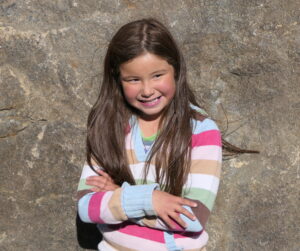
Our first activity as a group was lunch and a hike in Sylvia Grinnel Territorial Park, which introduced us to the unique foliage north of the tree line. The park also contains archaeological sites of the ancient Dorset and Thule peoples. While there, we met a very engaging young Inuk named Jenna, shown here hamming it up for the camera. She was with her family fishing near Sylvia Grinnel Falls.
I was chatting with fellow participant, Lorna Crozier, when Jenna approached us and offered to sing a song
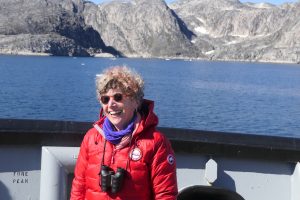
I soon learned that this friendly engagement, even with strangers, is a common part of Inuit culture. When, expecting to learn about some local singer celebrity, I asked her what her favourite singer was, perhaps I shouldn’t have been surprised that she answered “Katie Perry”.
Later our group toured the Nunatta Sunakkutaangit Museum, in the former Hudson’s Bay Company store, travelling there by our trusty yellow school bus.
There I saw a man whole seemed interested in our group, so I stopped and chatted with him. The video below explains why the talented artist was in Iqaluit. Jenna, riding her bike, was in the background of this interview, but got removed in editing. Charlie “C5” Johnston was definitely worth interviewing and, was it synchronicity for a person who brands himself “C5” to meet and interact with the “C3” group?
Later in Iqaluit, we got to meet many local people, including the scientists at Nunavut Research Institute, local artists, and kayak building at the local high school.
Days later, at the end of Leg 7 in Qikiqtarjuaq, most of our group climbed the hill overlooking the hamlet and the Canada C3 vessel, and we had a number of amazing encounters.
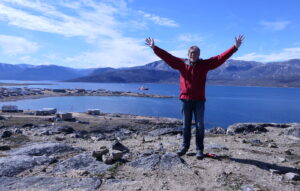
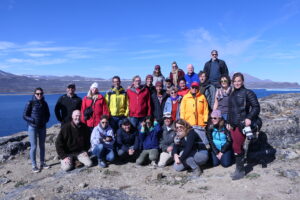
Initially I was surprised that the girl, shown above with her sister, had such a pro camera. Later, I learned that a journal and fellow participant Caroline G Murphy, had sportingly lent her camera. For more background on this budding young photographer, read Caroline’s article in Le Journal de Montréal J’ai Prêté ma Caméra a une Jeune Inuite de 9 Ans …

And, for those unable to read in French, our discussions on Diversity and Inclusion did encompass the original “Two Solitudes” in Canada, namely French and English. While Google can do a great job translating the article, the photos with the eye of a precocious 9 year old totally transcend traditional cultural divides.
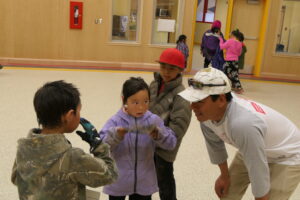
Our final community encounter during Leg 7 was at a ceremony in Qikiqtarjuaq where we gave hockey sticks to the local children, who seem to have a passion for hockey that transcends even southern Canada’s hockey crazy intensity. Leading the presentation was Jim Kyte, fellow participant and the first legally deaf NHL hockey player. Jim is an inspirational leader I was happy to get to know who has overcome challenges that most would shy away from. Today he serves as Dean of the School of Hospitality and Tourism at Algonquin College in Ottawa.
Jim was joined by last minute participant, David Lawson, an Inuk leader who just resigned after 15 years serving his community in the RCMP. I am sure we will hear much more from David who just started a law degree in order to better advocate for his people. For example, he is Board President of Embrace Life Council, an Iqaluit-based suicide prevention organization. In a separate post, I will write more about my journey of learning about the Inuit people and their journey to become a vital part of the fabric of our Canadian nation.
Canada C3 made for some wonderful encounters and conversations. I can only wish that every Canadian was able to share my experiences with the wonderful diversity that is Canada. Even I took a long time to process this life changing experience. In the end, I had my understanding of my own country transformed both by the special world that is Canada’s Arctic regions, but even more so by people who now have a life long bond that will lead to action. These conversations were far from superficial and already, many of us are taking action. As we enter 2018, you will start to learn more about the Canada C3 Legacy Programs which will keep the torch of this remarkable nation building alive and further spreading that light in the form of action and education.

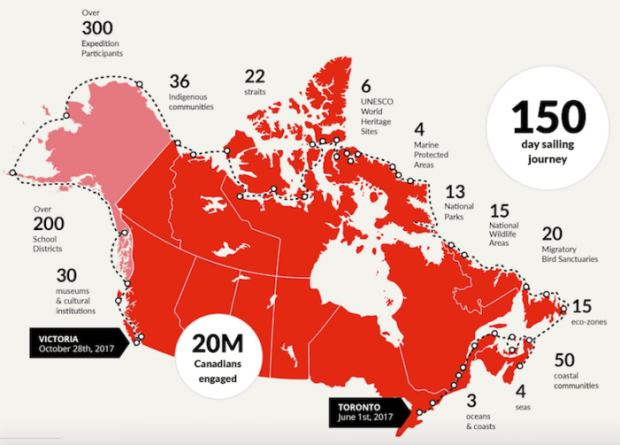
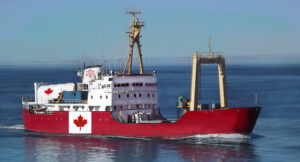
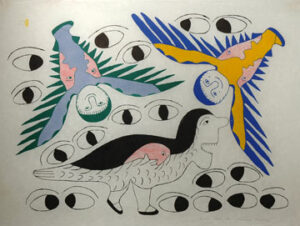
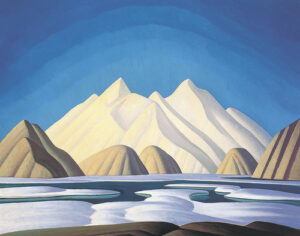
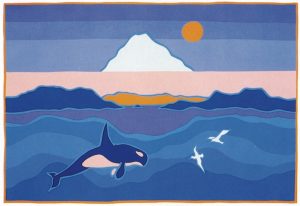
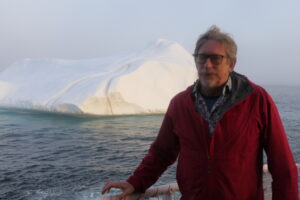
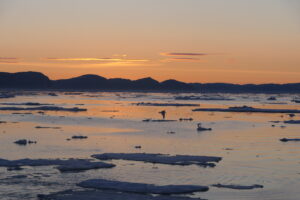
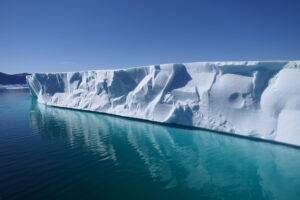
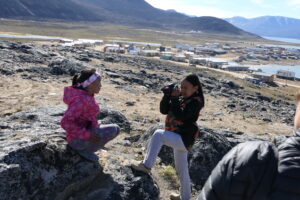
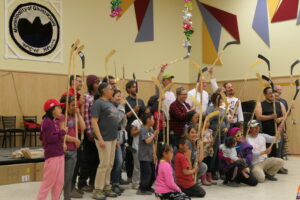
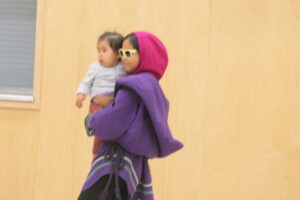
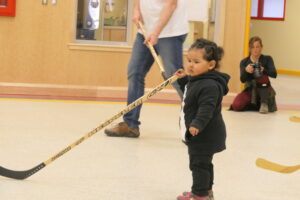
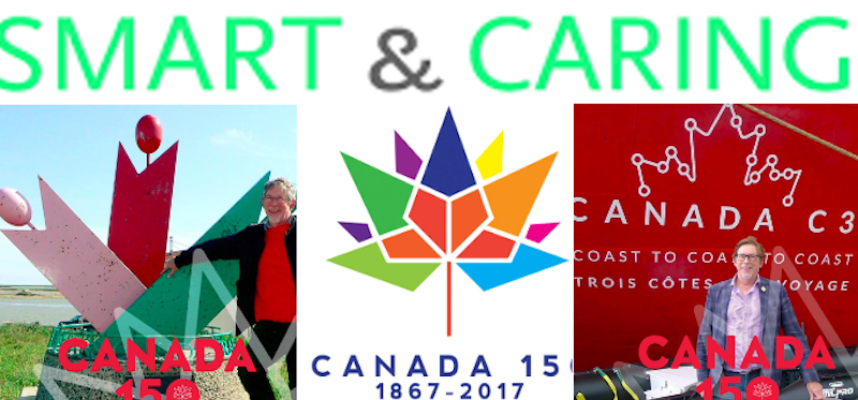

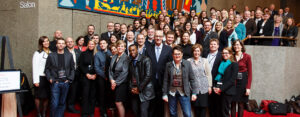
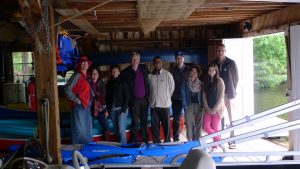
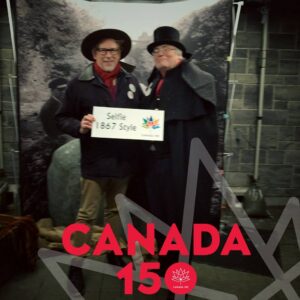
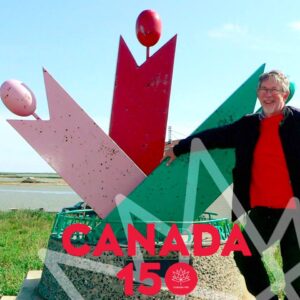
10 Jan 2018
0 CommentsEnvironmental Awakening Fusing of Science, The Arts and Sea Ice
The Canada C3 expedition had myriad program elements, including being an ideal platform for science. In all, over 25 major scientific experiments took advantage of circumnavigating Canada’s coastline, the longest in the world, with much of that in Arctic waters. The experiments, a collaboration with major research institutes across Canada, gathered much needed baseline data such as:
While none of these experiments were directly studying atmospheric carbon or climate directly, all exhibit the effects of these huge changes. That the Arctic is disproportionately impacted by climate change was directly visible to all participants. The temperature changes seen in polar regions are 3 times what we experience in the south, with our recent 1°C increase being more like 3°C up north. Thus, the Arctic is a harbinger of our own unmitigated climate future, making the Inuit ideal spokespeople to warn the rest of the world.
One of the great challenges faced by scientists is how share their stories in our modern, digital world in which a cacophony of voices clamber for our finite attention. The scientific method, honed over centuries, demands:
Thus, in communicating their knowledge, the challenge for scientists isn’t so much that they are the introverts of popular culture nor entirely that the science is perceived as dry and academic. In my many dialogues with scientists, the issue of finding new ways to communicate the important knowledge they possess to a populist audience, was a common lament. Scientists are ever searching to find new ways to help humanity truly understand their most portentous issues, such as Climate Change.
In this video, below, you can see one amazing scientist, Bianca Perren, explaining the tabular iceberg (see photos at the top of this article) that we saw when we came toward land from the Davis Strait. Bianca, being a painter, educator and Zodiac driver on top of her work as a palæoclimatologist and quarternary scentist at the British Antarctic Survey, is sending an emotionally powerful message about the last ice shelfs remaining in the Arctic. By the way, she also makes a cameo appearance in Al Gore’s recent film, An Inconvenient Sequel during work at Swiss Camp in Greenland.
Leveraging the incredible wealth of scientific talent, the wonderfully diverse set of participants helped weave a complex tapestry of knowledge and understanding. For me it was a once in a lifetime chance to participate in a rare melding of scientists working in an environment alive with poets, teachers, journalists, artists, community activists, indigenous and youth ambassadors. The eclectic combination created a magic environment while onboard, but gave some clues as to how to unlock the dilemma about communications with ordinary Canadians, both in planned and chance conversations.
Here is a brief rundown of a few of the remarkable participants just on Leg 7 of Canada C3:
Lorna Crozier is a Governor-General Award winning poet, and Officer of the Order of Canada, living in Victoria. I was soo impressed by Lorna’s magic ability to help all of us “break through the ice” and reach new levels of understanding, for example with her poem, Polar, uniquely capturing our experience onboard. Phil Irish is a visual artist and teacher based in Elora who was selected to be one of 15 artists, one per Leg, through a fiercely competitive, Canada Council led selection process. Phil, constantly sketching and painting, inspired all of us with his visual perspective on our Leg 7 experience and built on his own environmentally driven recent practice. Likewise, Paul Rogalsi of Rouge Restaurant in Calgary, was one of 15 chefs, selected for Leg 7 from Food Day Canada chefs from coast to coast to coast. Paul was a thoughtful contributor not just gastronomically, but also as an avid environmentalist keen on sustainable living.
Peter Poole is a renaissance man who is deeply involved in his community of Banff, Alberta and the larger world. He is a change maker with a deep commitment to conservation and honouring indigenous elders which shine through in all of his endeavours. Through other projects, he is also a very good friend. Tony Dekker is the lead singer and songwriter for Canadian indie-folk group Great Lake Swimmers. Tony is a thoughtful and down to earth musician with a strong interest in nature and relationships. Even at 19 years of age, Benoit Dupras, a Youth Ambassador on Leg 7 from northern Québec, is on a course to change the world. He is indicative of a new generation of Francophone Canadian leaders and, in his case, he aims to be a major force to move Canada, and the world, away from fossil fuels to a green energy future.
This last group represented Leg 7 participants from Canada’s Indigenous peoples, collectively, First Nations, Métis, and Inuit. In a later post, I will more fully explore some of the Reconciliation dialogue from Canada C3.
Taivitii (David) Lawson is an emerging Canadian Inuit leader originally from traditional lands near Pangnirtung and now living in Iqaluit. David was in the RCMP for 15 years and just prior to the Expedition, was about to embark on training to be a lawyer to “be an advocate for the Inuit people.” David has been an activist in a number of community issues, including suicide prevention through Embrace Life Council. Because David was a last minute replacement, there isn’t a bio on the C3 website. Joshua Stribbell is President, National Urban Inuit Youth Council and runs a program for Inuit youth in Toronto called Torontomiutaujugut. He grew up in Southern Ontario because his mother was adopted out in the Sixties Scoop. He has only recently started to re-connect with his Inuit heritage. A Youth Ambassador and member of the Matawa First Nation, born and raised in the urban setting of Thunder Bay, Tyler Waoose also aimed to re-connect with his ancestral heritage in the northern Canadian Arctic. Tyler is active in Roots to Harvest, engaging youth with agriculture and cultivating heathy communities.
Our onboard dialogues were both planned and an by chance encounter. We had an onboard, Hollywood level “Comms Team” of 6 people constantly shooting and producing amazing content to share with Canada and the world. As mentioned, the goal was to reach over 20 million Canadians, which I believe was handily achieved in channels as diverse as Facebook Live to traditional print journalism. As a result, even thought the participant base was limited, the majority of Canadian participated to greater or lesser degrees in the education and conversation about our future. I also committed to share in various ways, including writing a series of blog posts (like this one!).
One particularly important session was organized by very thoughtful participant Peter Poole. He had several scientists, youth, artists, indigenous people and other present their thoughts on what Climate Change meant to them both personally and professionally. Being involved in my own work to “reboot the narrative around climate change”, this particular session inspired and motivated me to carry on the conversations that Peter started. While there will be more on my initiative as it evolves, it was clear that this session got many to commit to being ongoing ambassadors and champions of the unique Climate Change perspectives from the north. Also, now in 2018, watch out for various more formalized Canada C3 Legacy Projects as they are unveiled during this year.
While I could go on endlessly about Canada C3 and the environment, hopefully this does give you a taste. Collectively, I can only give a small glimpse of how the Canada C3 expedition was a life-changing one for me and all participants. The learnings weren’t so much the hard science, but instead the storytelling and narrative challenges standing in the way of getting us all onboard.
To wrap up, just as Chef Paul Rogalski always reminded us that “The foundation of great food starts with the ingredients…’, so too does making the world better start with great people. I will leave the last word to none other than that master of words, Lorna Crozier. I love the picture she paints tying in so well, and viscerally, to the earlier words of scientists like Bianca Perren who has dedicated her life to Polar Climate Science. What action will you take in response.